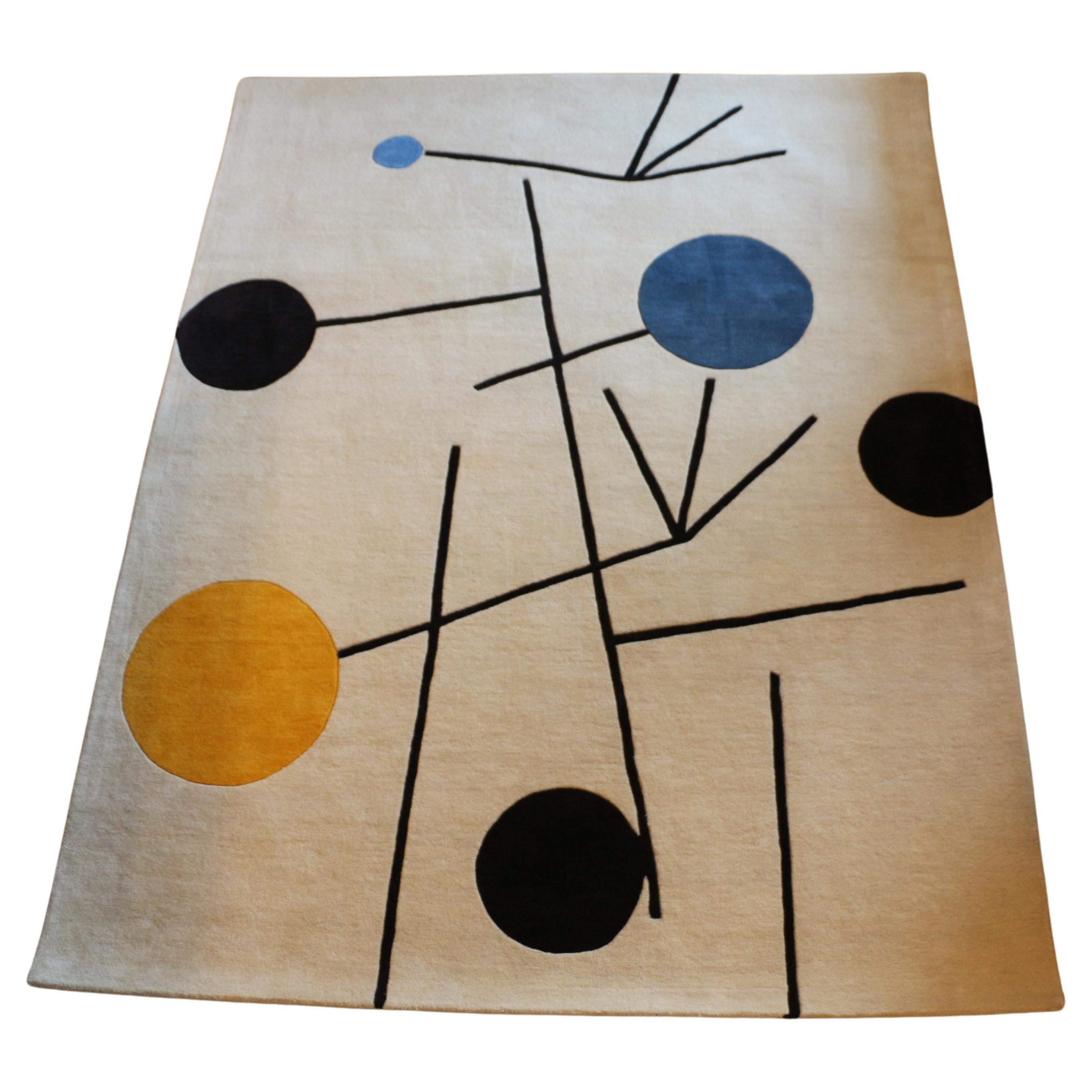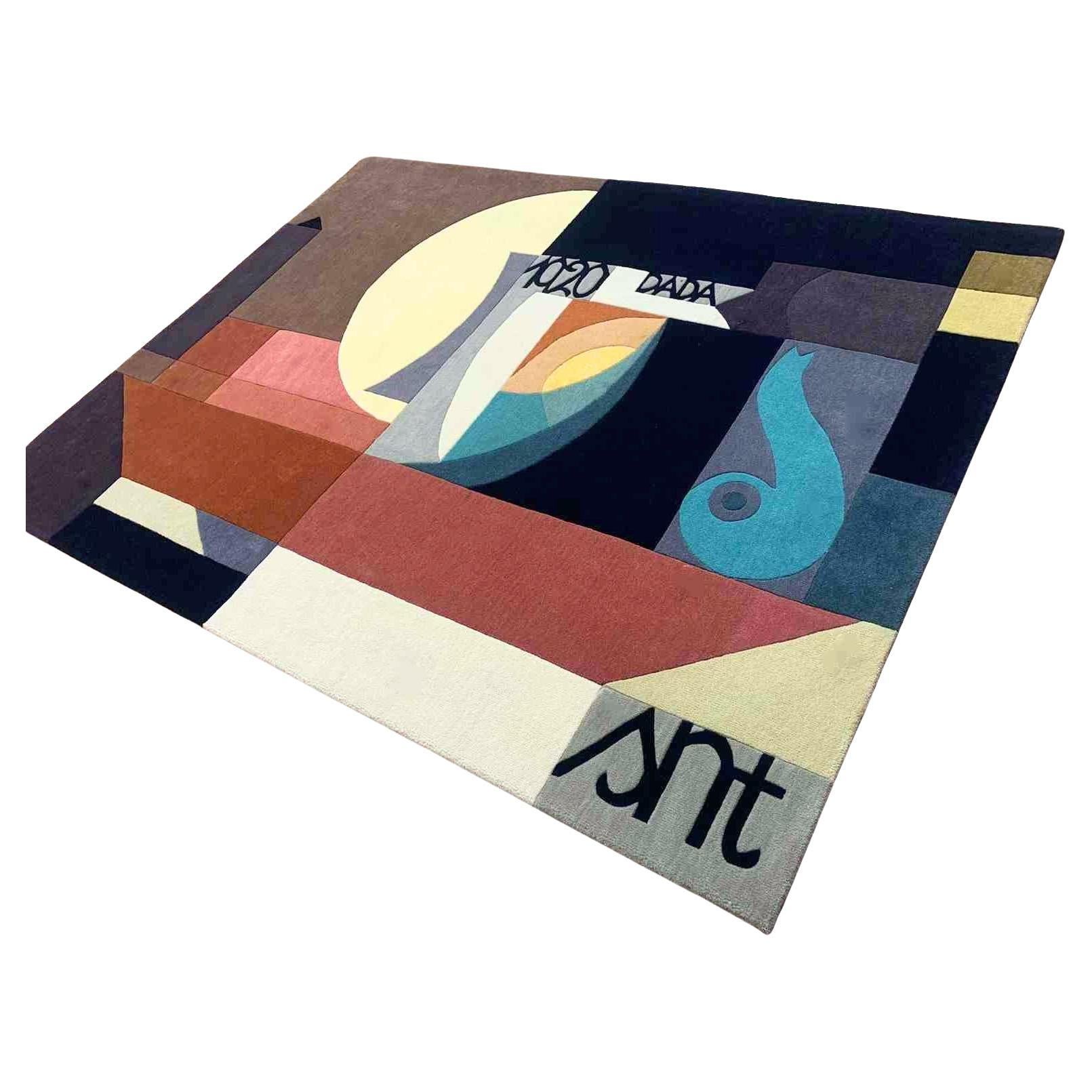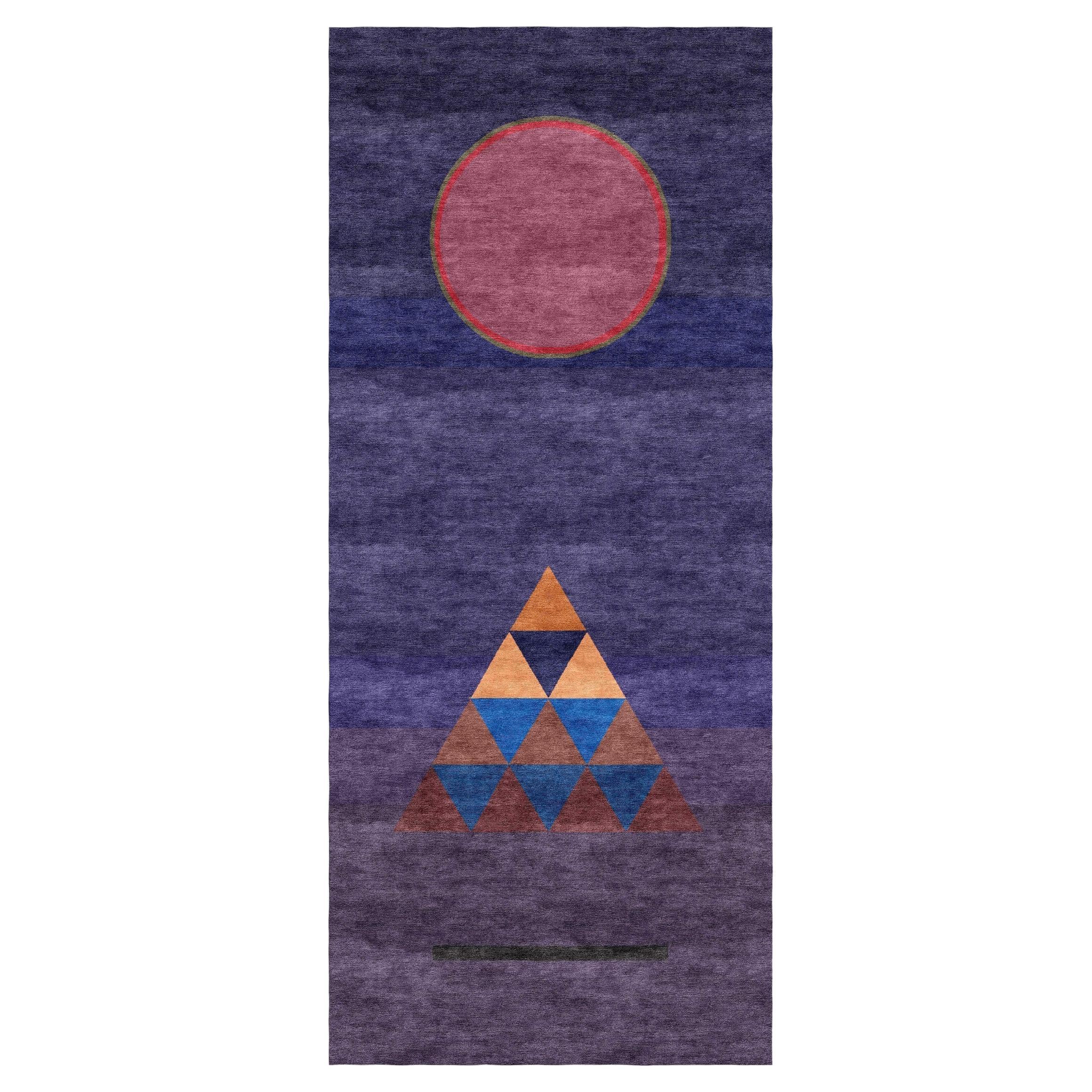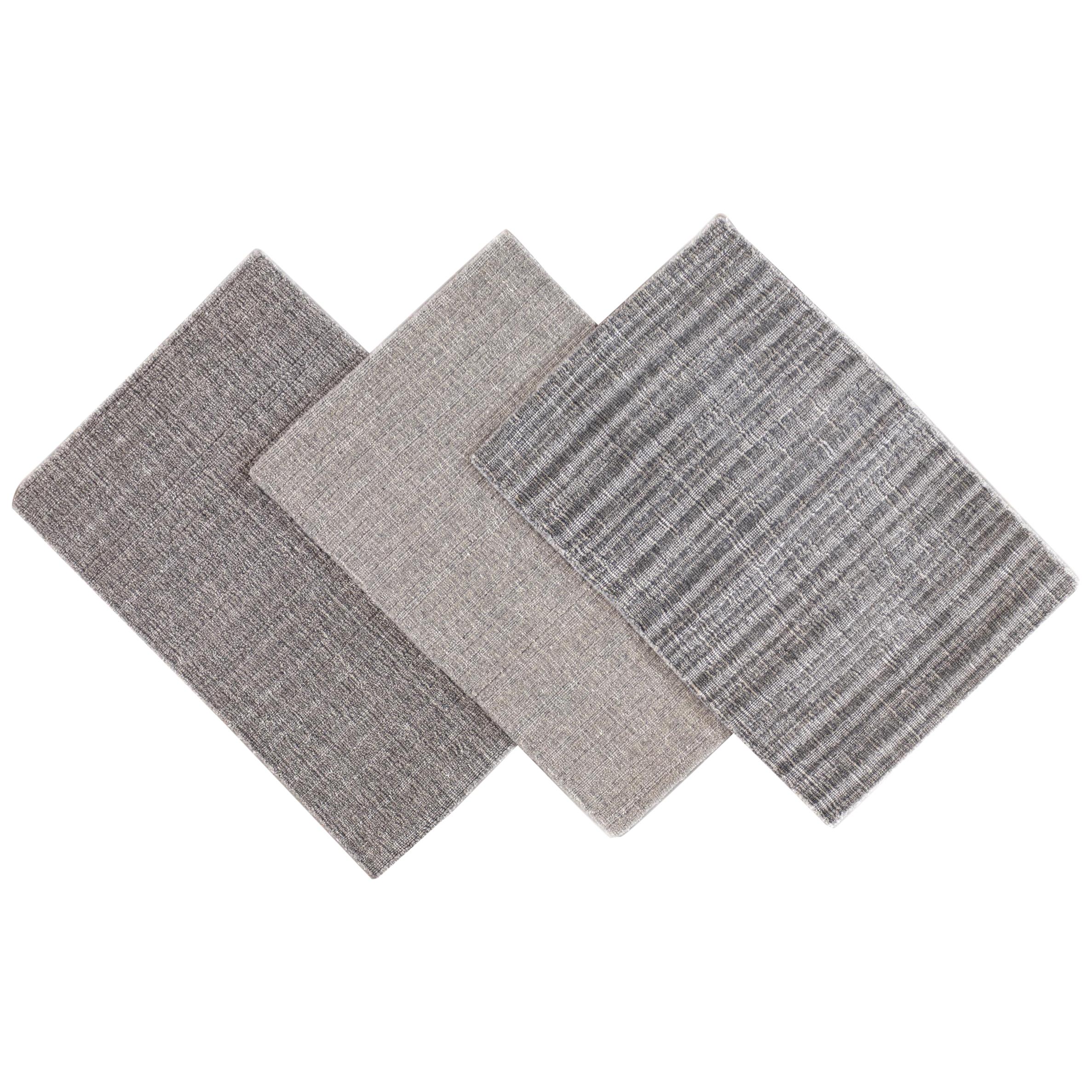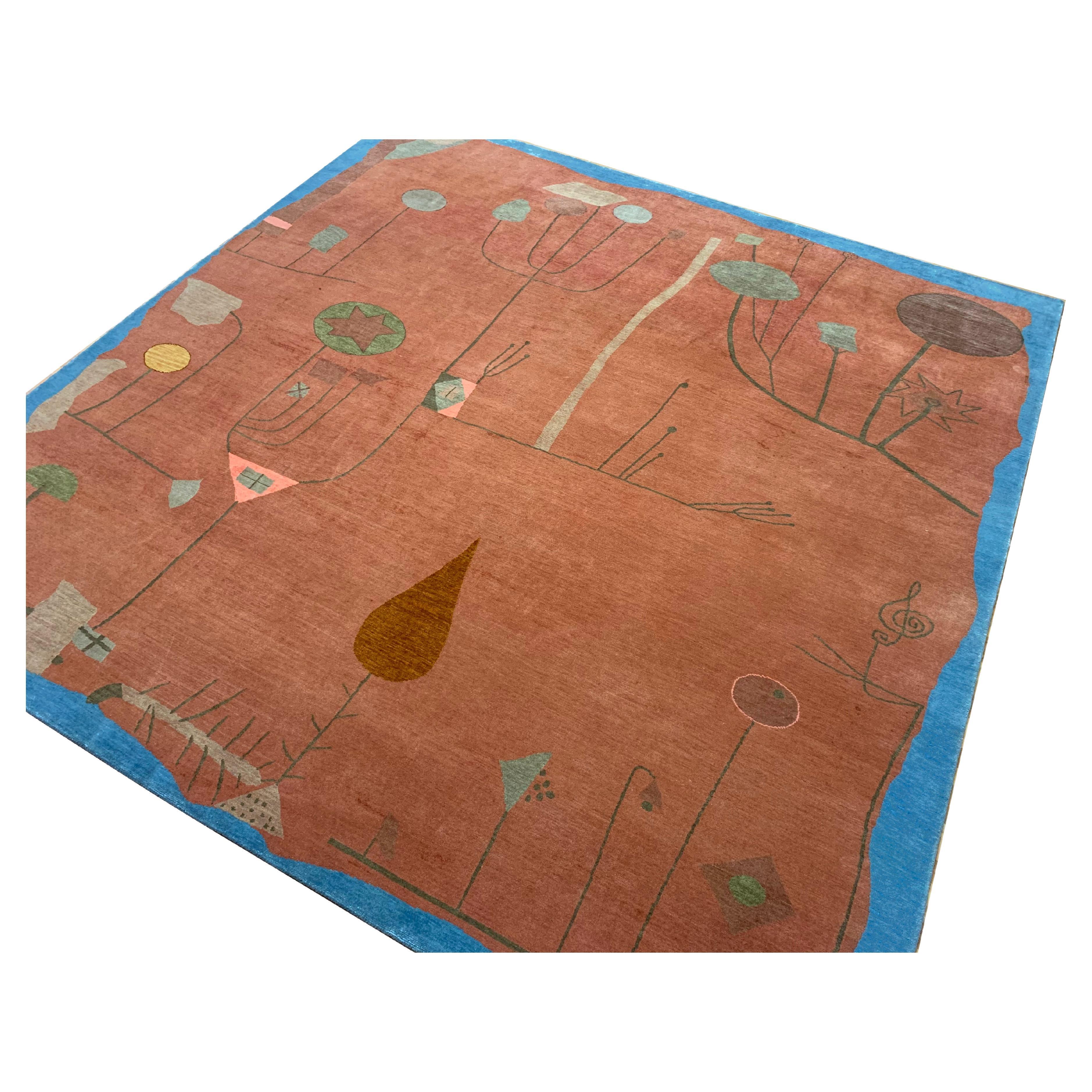Items Similar to Custom Hand knotted Rug, after Sophie Taeuber-Arp “Rising Falling Flying”. Wool
Video Loading
Want more images or videos?
Request additional images or videos from the seller
1 of 12
Custom Hand knotted Rug, after Sophie Taeuber-Arp “Rising Falling Flying”. Wool
About the Item
Custom hand knotted rug based on the painting “Rising Falling Flying” by Sophie Taeuber-Arp.
Sustainable and certified fair-trade artisanal production. Label Step fair-trade partners.
Colors: 5 custom-dyed colors. Main colors in the rug: cream white, goldenrod yellow, black, medium blue and royal blue.
Material: fine New Zealand wool, with further options upon request.
Quality: Hand knotted, 100 knots per square inch.
Numbered limited edition of maximum 100 fine handmade rugs with this art piece. Each rug comes with a sewn-on label with an image of the artist’s signature and numbered by hand, per order.
This beautiful rug can also be ordered in even more luxurious materials like pure silk or mohair, as well as in plant-based materials like Tencel and linen and also in the hand tufted technique. A combination of materials is possible as well. Production time may increase for these options, depending on material availability.
Production time for this rug is between is approximately 8-10 weeks. For environmental reasons and to provide our full bespoke service, our rugs are always made to order.
-- About the artwork on which this rug is based:
The painting Équilibre – Surgissant, tombant, adhérent, volant (or Rising Falling Flying in English) is one of Taeuber-Arp’s most celebrated works.
This painting was created in 1934 and is composed of different shapes and colors placed together in a highly calculated way to create a sense of balance and vibrant energy.
This is a masterpiece of geometric abstraction that is comprised of symmetrical shapes that create a maze-like pattern that invites the viewer to delve into its depths.
Taeuber-Arp was a master of color and form, and Rising Falling Flying reflects this in her mix of bold primary colors, transforming them into powerful visual tools that electrify the painting.
The work is a testament to Taeuber-Arp’s desire to capture the essential vibration of life itself in the interplay between shape and color.
What makes this standout piece of art is its unique composition of shapes and colors. The shapes are deliberately positioned to create balance and harmony while giving the impression of unbridled energy. Each shape is carefully placed to help viewers feel as if they are moving through space. The painting’s symmetrical and interwoven shapes were groundbreaking in the art world, and its influence can still be seen in contemporary art today.
-- About Sophie Taeuber-Arp:
“The intrinsic decorative urge should not be eradicated. It is one of humankind’s deep-rooted, primordial urges. Primitive people decorated their implements and cult objects with a desire to beautify and enhance…. it is a sense emanating from the urge for perfection and creative accomplishment.” Sophie Taeuber-Arp
Sophie Taeuber-Arp was one of the foremost abstract artists and designers of the twentieth century. Her sophisticated graphic and textile works are among the earliest Constructivist works. They reflect the interplay between colour and form. She explored the circle as the representation of the cosmic metaphor, the form that contains all others.
She and her husband Jean Arp were involved with the Dada movement and were close friends of artists such as Sonia and Robert Delaunay, Wassily Kandinsky, Joan Miró, and Marcel Duchamp.
Wassily Kandinsky said: “Sophie Taeuber-Arp expressed herself by means of the ‘colored relief,’ especially in the last years of her life, using almost exclusively the simplest forms, geometric forms. The forms, by their sobriety, their silence, their way of being sufficient unto themselves, invite the hand, if it is skillful, to use the language that is suitable to it and which is often only a whisper; but often too the whisper is more expressive, more convincing, more persuasive, than the ‘loud voice’ that here and there lets itself burst out.”
When you purchase a handmade carpet from Rug Your Life, Label STEP Fair Trade Partner, you help improve the lives of the people who created it and their families’.
- Creator:( After ) Sophie Taeuber (Artist)
- Dimensions:Width: 74.02 in (188 cm)Length: 94.49 in (240 cm)
- Style:Bauhaus (In the Style Of)
- Materials and Techniques:
- Place of Origin:
- Period:
- Date of Manufacture:2023
- Production Type:New & Custom(Limited Edition)
- Estimated Production Time:9-10 weeks
- Condition:
- Seller Location:Munich, DE
- Reference Number:1stDibs: LU9348237482432
Shown net price applies to the listed size, hand knotted in 100 knots per square inch, in wool. Bespoke dimensions and other materials such as mohair, pure silk, tencel and linen can be requested. Custom rug shapes (for example for stairs or wall-to-wall) upon request. Also in hand tufted technique.
Net prices in EUR for fine, soft wool, hand knotted construction:
150 x 192 cm / 4.9 x 6.3 ft: 2.008 €;
188 x 240 cm / 6.2 x 7.9 ft: 3.185 €;
225 x 288 cm / 7.4 x 9.4 ft: 4.580 €;
About the Seller
No Reviews Yet
Vetted Seller
These experienced sellers undergo a comprehensive evaluation by our team of in-house experts.
1stDibs seller since 2023
- ShippingRetrieving quote...Ships From: Bhadohi, India
- Return PolicyThis item cannot be returned.
More From This SellerView All
- Custom Hand Tufted Rug, after Sophie Taeuber-Arp “Rising Falling Flying”. WoolBy ( After ) Sophie TaeuberLocated in Munich, DECustom hand tufted rug based on the painting “Rising Falling Flying” by Sophie Taeuber-Arp. Sustainable and certified fair-trade artisanal production. Label Step fair-trade partners...Category
2010s Indian Bauhaus Indian Rugs
MaterialsWool
- Custom Hand tufted Rug, “Dada Composition" (1920) After Sophie Taeuber-ArpBy ( After ) Sophie TaeuberLocated in Munich, DECustom hand tufted rug based on (after) the painting “Dada Composition” by Sophie Taeuber-Arp. Colors: 25 custom-dyed colors. Main colors in the rug: brown, cream, red and grey. M...Category
2010s Indian Bauhaus Indian Rugs
MaterialsWool
- Custom Hand knotted Rug, after Wassily Kandinsky “Composition VIII”. Wool, silkBy (after) Wassily KandinskyLocated in Munich, DECustom hand knotted rug based on the painting “Composition VIII” by Bauhaus master painter Wassily Kandinsky. Sustainable and certified fair-trade artisanal production. Label Step ...Category
2010s Indian Bauhaus Indian Rugs
MaterialsOther
- Custom Hand knotted Rug: “Conclusion" After Wassily KandinskyBy (after) Wassily KandinskyLocated in Munich, DECustom hand knotted runner rug based on the painting “Conclusion” by Bauhaus master painter Wassily Kandinsky (original German title “Schluss”). The original proportions of the paint...Category
2010s Indian Bauhaus Indian Rugs
MaterialsOther
- Custom Hand knotted Rug, after Paul Klee “Fruits on Red”. Bauhaus. Brown. Wool.By (after) Paul KleeLocated in Munich, DECustom hand knotted rug based on the painting “Fruits on Red” by Paul Klee. Sustainable and certified fair-trade artisanal production. Label Step fair-trade partners. Colors: 13 custom-dyed colors. Main colors in the rug: sienna brown, cerulean blue, maroon brown, sage green, and a warm combination of wheat cream, tan beige and cantaloupe. Material: fine New Zealand wool, with further options upon request. Quality: Hand knotted, 150 knots per square inch. Numbered limited edition of maximum 100 fine handmade rugs with this art piece. Each rug comes with a sewn-on label with an image of the artist’s signature and numbered by hand, per order. This beautiful rug can also be ordered in even more luxurious materials like pure silk or mohair, as well as in plant-based materials like Tencel and linen and also in the hand tufted technique. A combination of materials is possible as well. Production time may increase for these options, depending on material availability. Production time for this rug is between is approximately 12 weeks. For environmental reasons and to provide our full bespoke service, our rugs are always made to order. -- About the artwork on which this rug is based: Paul Klee painted Fruits on Red (original title in German: Früchte auf Rot) in 1930 in Dessau, where Klee had moved from Weimar with the Bauhaus. The delicate, constructed architectonics of this artwork ideally exemplifies Klee’s insight into the anatomy of the objects. The original painting is at the Lenbachhaus in Munich, Germany. You can now have this fine Paul Klee Fruits on Red custom rug made by hand for you, in your desired custom size. -- About Paul Klee: “The art of mastering life is the prerequisite for all further forms of expression.” Paul Klee Swiss artist Paul Klee was born on December 18th, 1879. Art played...Category
2010s Indian Bauhaus Indian Rugs
MaterialsWool, Silk, Linen, Mohair
- Custom Hand knotted Rug: “Impression III (Concert)" After Wassily KandinskyBy (after) Wassily KandinskyLocated in Munich, DECustom hand knotted rug based on the painting “Impression (Concert)” by Bauhaus master painter Wassily Kandinsky. Sustainable and certified fair-trade artisanal production. Label St...Category
2010s Indian Bauhaus Indian Rugs
MaterialsOther
You May Also Like
- Hand Knotted Wool Custom RugLocated in Norwalk, CTSolid-colored wool textured custom rug. Custom sizes and colors made-to-order. Material: Wool Lead Time: Approx. 15-20 weeks available Colors: As shown, other custom colors and...Category
21st Century and Contemporary Tibetan Modern Indian Rugs
MaterialsWool
- Abstract Dadaist Contemporary Rug Inspired by Sophie Taeuber ArpLocated in Geneve, CHAbstract Dadaist contemporary rug inspired by Sophie Taeuber Arp Artist: Sophie Taeuber Arp Dimensions: W 170 x D 240 CM New-Zealand wool and silk Ja...Category
2010s New Zealand Modern Western European Rugs
MaterialsWool
- Abstract Dadaist Contemporary Rug Inspired by Sophie Taeuber ArpLocated in Geneve, CHAbstract Dadaist contemporary rug inspired by Sophie Taeuber Arp. Artist: Sophie Taeuber Arp Dimensions: W 170, D 240 cm New-Zealand wool and silk. Japanese Abstractions is a collection of nine pieces, all designed around the concept of the imaginary trip to Japan of the Dadaist and feminist artist Sophie Taeuber Arp. Each rug is a combination of geometric shapes and traditional Japanese patterns, a result of the unexpected yet poetic encounter between pure abstraction and cultural influences, between West and East. Sophie Taeuber-Arp Biography (1889–1929) Sophie Henriette Gertrud Taeuber was born on January 19, 1889 in Davos-Platz, Switzerland. From 1904 to 1907 she attended the Stauffacher-Schule and the drawing school at the Industrie- und Gewerbemuseum, or the museum for industry and design, in St. Gallen. In 1910 she began her studies at the Lehr- und Versuchsateliers für angewandte und freie Kunst in Munich, a reformed art school that sought to synthesize the visual and applied arts. After an additional semester at the school of applied arts in Hamburg in 1914, her student days came to an end. She joined the Schweizerischer Werkbund in 1915, the same year that she met Hans Arp. Enthused about her work, he encouraged her to devote herself to it even more fully. The artists’ close collaboration resulted in collages, sculptures and textile designs. Sophie Taeuber took lessons in movement arts from Rudolf von Laban, a founder of modern dance. She appeared as a dancer at the Dada-Soirées at the Cabaret Voltaire and the Galerie-Dada. Later on, she choreographed her own pieces. On May 5, 1916, she took over the textile class at the applied arts school in Zurich. In 1918, she also became a member of the artist’s association Das Neue Leben (New Life). At the same time, she undertook the design of stage backdrops and marionettes for Carlo Gozzi’s rendition of the opera König Hirsch. On October 20, 1922, she married Hans Arp. In 1925, Taeuber-Arp was appointed a member of the Swiss jury at the Exposition Internationale des Arts Décoratifs et Industriels in Paris. Her works won prizes and were shown in the International Exhibition of Modern Tapestries in Toledo, Ohio, USA. Sophie Taeuber-Arp and Hans Arp became French citizens in 1926. Through her connections with the Horn brothers, she secured contracts to design the interiors for various buildings, including the Aubette in Strasbourg. In turn, she asked Hans Arp and Theo van Doesburg to collaborate with her on this large scale project. Around the same time, she had a studio-home built according to her own plans in Clamart, near Paris. Having left her teaching post in Switzerland in 1929, Sophie Taeuber-Arp settled permanently in France. In collaboration with Marcel-Eugéne Cahen, she also realized the renovation and redesign of the Parisian Galerie Goemans. Sophie Taeuber-Arp Biography (1930–1943) In Paris, Sophie Taeuber-Arp joined the artists’ group Cercle et Carré and participated in their exhibitions. In 1931 she became a member of the association Abstraction-Création. Her artist friends Theodor and Woty Werner hired her to design the interior of their Paris apartment. A year later, in 1932, she left the Schweizerischer Werkbund. Her visit to the Sztuki Museum in Lodz, which was facilitated by Jan Brzekowski, led to a fruitful artistic exchange between the Polish avant-garde association a.r. and the Parisian artist’s group Abstraction-Création. Sophie Taeuber-Arp participated in various group exhibitions, and often showed her work with Artistes Suisses at the Galerie Vavin and at the Kunsthalle Bern with Hans Arp, Kurt Seligmann, Hans Schiess, and many others. She designed the layout for Anatole Jakovskis’ book Hans Erni, Hans Schiess, Kurt Seligmann, S. H. Taeuber-Arp, Gerard Vulliamy in 1935. Theodor and Woty Werner helped her secure the commission to design the interior of the Bauhaus professor Ludwig Hilberseimer’s Berlin apartment. Her work was shown in the exhibition These, Antithese, Synthese at the Kunstmuseum Luzern and in 1936 in Zeitprobleme in der Schweizer Malerei und Plastik, an exhibition of contemporary Swiss painting and sculpture, at the Kunsthaus Zürich. Additionally, she participated in the Konstruktivisten-Ausstellung, an exhibition of constructivist art, at the Kunsthalle Basel. Sophie Taeuber-Arp founded the international artists’ journal plastique with César Domela, A. E. Gallatin and L. K. Morris in 1937. The same year she joined the Swiss artists’ group Allianz. In 1938, she exhibited at the Exposition internationale du Surréalisme in Paris and at the Exposition of Contemporary Sculpture in London...Category
2010s New Zealand Modern Western European Rugs
MaterialsWool
- Abstract Dadaist Contemporary Rug Inspired by Sophie Taeuber ArpLocated in Geneve, CHAbstract Dadaist contemporary rug inspired by Sophie Taeuber Arp Artist: Sophie Taeuber Arp Dimensions: W 240, D 240 cm New-Zealand wool and silk Jap...Category
2010s New Zealand Modern Western European Rugs
MaterialsWool
- Abstract Dadaist Contemporary Rug Inspired by Sophie Taeuber ArpLocated in Geneve, CHAbstract Dadaist contemporary rug inspired by Sophie Taeuber Arp Artist: Sophie Taeuber Arp Dimensions: W 170, D 240 cm New-Zealand wool and silk Japanese Abstractions is a collection of nine pieces, all designed around the concept of the imaginary trip to Japan of the Dadaist and feminist artist Sophie Taeuber Arp. Each rug is a combination of geometric shapes and traditional Japanese patterns, a result of the unexpected yet poetic encounter between pure abstraction and cultural influences, between West and East. SOPHIE TAEUBER-ARP Biography (1889–1929) Sophie Henriette Gertrud Taeuber was born on January 19, 1889 in Davos-Platz, Switzerland. From 1904 to 1907 she attended the Stauffacher-Schule and the drawing school at the Industrie- und Gewerbemuseum, or the museum for industry and design, in St. Gallen. In 1910 she began her studies at the Lehr- und Versuchsateliers für angewandte und freie Kunst in Munich, a reformed art school that sought to synthesize the visual and applied arts. After an additional semester at the school of applied arts in Hamburg in 1914, her student days came to an end. She joined the Schweizerischer Werkbund in 1915, the same year that she met Hans Arp. Enthused about her work, he encouraged her to devote herself to it even more fully. The artists’ close collaboration resulted in collages, sculptures and textile designs. Sophie Taeuber took lessons in movement arts from Rudolf von Laban, a founder of modern dance. She appeared as a dancer at the Dada-Soirées at the Cabaret Voltaire and the Galerie-Dada. Later on, she choreographed her own pieces. On May 5, 1916, she took over the textile class at the applied arts school in Zurich. In 1918, she also became a member of the artist’s association Das Neue Leben (New Life). At the same time, she undertook the design of stage backdrops and marionettes for Carlo Gozzi’s rendition of the opera König Hirsch. On October 20, 1922, she married Hans Arp. In 1925, Taeuber-Arp was appointed a member of the Swiss jury at the Exposition Internationale des Arts Décoratifs et Industriels in Paris. Her works won prizes and were shown in the International Exhibition of Modern Tapestries in Toledo, Ohio, USA. Sophie Taeuber-Arp and Hans Arp became French citizens in 1926. Through her connections with the Horn brothers, she secured contracts to design the interiors for various buildings, including the Aubette in Strasbourg. In turn, she asked Hans Arp and Theo van Doesburg to collaborate with her on this large-scale project. Around the same time, she had a studio-home built according to her own plans in Clamart, near Paris. Having left her teaching post in Switzerland in 1929, Sophie Taeuber-Arp settled permanently in France. In collaboration with Marcel-Eugéne Cahen, she also realized the renovation and redesign of theParisian Galerie Goemans. SOPHIE TAEUBER-ARP Biography (1930–1943) In Paris, Sophie Taeuber-Arp joined the artists’ group Cercle et Carré and participated in their exhibitions. In 1931 she became a member of the association Abstraction-Création. Her artist friends Theodor and Woty Werner hired her to design the interior of their Paris apartment. A year later, in 1932, she left the Schweizerischer Werkbund. Her visit to the Sztuki Museum in Lodz, which was facilitated by Jan Brzekowski, led to a fruitful artistic exchange between the Polish avant-garde association a.r. and the Parisian artist’s group Abstraction-Création. Sophie Taeuber-Arp participated in various group exhibitions, and often showed her work with Artistes Suisses at the Galerie Vavin and at the Kunsthalle Bern with Hans Arp, Kurt Seligmann, Hans Schiess, and many others. She designed the layout for Anatole Jakovskis’ book Hans Erni, Hans Schiess, Kurt Seligmann, S. H. Taeuber-Arp, Gerard Vulliamy in 1935. Theodor and Woty Werner helped her secure the commission to design the interior of the Bauhaus professor Ludwig Hilberseimer’s Berlin apartment. Her work was shown in the exhibition These, Antithese, Synthese at the Kunstmuseum Luzern and in 1936 in Zeitprobleme in der Schweizer Malerei und Plastik, an exhibition of contemporary Swiss painting and sculpture, at the Kunsthaus Zürich. Additionally, she participated in the Konstruktivisten-Ausstellung, an exhibition of constructivist art, at the Kunsthalle Basel. Sophie Taeuber-Arp founded the international artists’ journal plastique with César Domela, A. E. Gallatin and L. K. Morris in 1937. The same year she joined the Swiss artists’ group Allianz. In 1938, she exhibited at the Exposition internationale du Surréalisme in Paris and at the Exposition of Contemporary Sculpture in London...Category
2010s New Zealand Modern Western European Rugs
MaterialsWool
- Abstract Dadaist Contemporary Rug Inspired by Sophie Taeuber ArpLocated in Geneve, CHAbstract Dadaist contemporary rug inspired by Sophie Taeuber Arp Artist: Sophie Taeuber Arp Dimensions: W 170 x D 240 cm New Zealand wool and silk Ja...Category
2010s New Zealand Modern Western European Rugs
MaterialsWool
